Every April, our editors report back on how they spent their time at the Northeast Astronomy Forum (NEAF), the world's largest astronomy and space tradeshow.
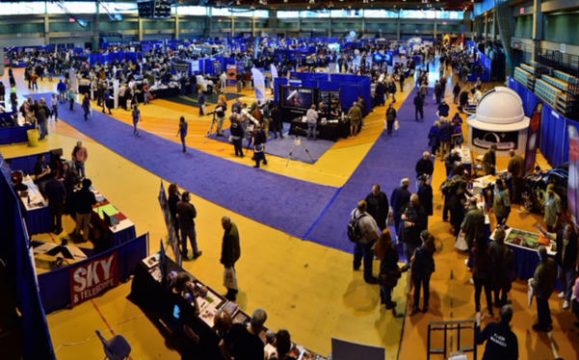
Sean Walker (S&T)
Our editors have just returned from the Northeast Astronomy Forum (NEAF), the world’s largest astronomy and space tradeshow. NEAF happens every spring at Rockland Community College in Suffern, New York. Hosted and organized by the non-profit Rockland Astronomy Club, NEAF is two days of non-stop astro fun. In addition to the exhibition floor, which held booths from 120 vendors and exhibitors this year, there was a full slate of experts lecturing on recent developments in astronomy and space exploration, a solar-observing field, and a special children’s area. The Northeast Pro/Am Conference, a lecture series that brings together the work of professional and amateur astronomers, ran in a classroom adjacent to the main exhibition hall. Many NEAF attendees also attended the Northeast Astro-Imaging Conference (NEAIC), a two-day meeting featuring workshops and lectures by both amateur and professional astroimagers.
As always, Sky & Telescope had a booth on the main exhibition floor, and our editors spent an exhilarating weekend talking to our readers — young and old — and handing out complimentary issues of our magazine. Of course, we also made some time to explore all NEAF has to offer; here are some of our impressions of a very full, very fun weekend:
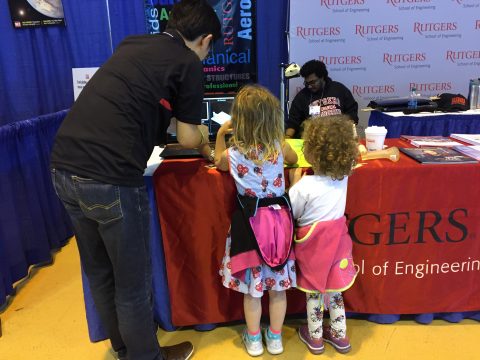
Peter Tyson (S&T)
Editor in Chief Peter Tyson: This weekend’s Northeast Astronomy Forum came through with all the usual elements that we at S&T savor at this increasingly popular expo: Seeing friends old and new. Checking out gear that can make your jaw drop. Chatting with long-time advertisers and thanking them for their business and support. There’s more: Meeting our core audience (you) face to face. Learning new things in booth-side chats. And hearing talks by leading professional and amateur astronomers as well as others in our broad community.
All those ingredients were there in spades. But the one dish that stood out for me above all others — like that one globular or planetary on an evening of stargazing that just really did it for you that night — was the children. They served up all the expected delightful surprises and diversions.
There were the two tousled-haired young sisters, perhaps 4 and 6, who danced around the Rutgers booth next to ours in their pink and white outfits for half an hour, clearly having a ball while their dad enjoyed a long chat with those behind the counter. There was the toddler boy who insisted on bringing our 6-inch Earth and Moon globes close together on the table so that they could talk to each other. There was the boy who got his father to take the ride in the kids’ area that spins you around like Sandra Bullock’s character in Gravity. After the dad clambered out of the contraption, a little wobbly but smiling, I told him that you couldn’t pay me to attempt that lose-your-lunch device. His pre-teen son beamed.
My favorite was a wee thing in a long-sleeved pink shirt and matching shoes, with brown curls and a serious expression, who sidled up to the booth with her parents. Maybe 4 years old, she had the look of someone who considers herself very much in charge. I thought, “Oh boy, they’ve got their hands full.”
As she planted her two tiny paws on the table between us, I said to her, “Would you like to hold the Moon?” and handed her our prototype 6-inch globe. This tiny creature with a grave face took the orb between her palms and pondered it expressionlessly for a moment. I wondered if she might throw it to the ground in a fit of pique. But a second later she glanced up at me and broke into a huge grin. She’d suddenly become the most adorable creature on the floor.
And in my mind, she became the temporary poster child for the future of our hobby. If we can draw forth instant beaming like that in thousands of other youngsters when we showcase celestial wonders, we’ll have nothing to worry about.
Thank you to Ed Siemenn and everyone at the Rockland Astronomy Club for pulling off another stunner.
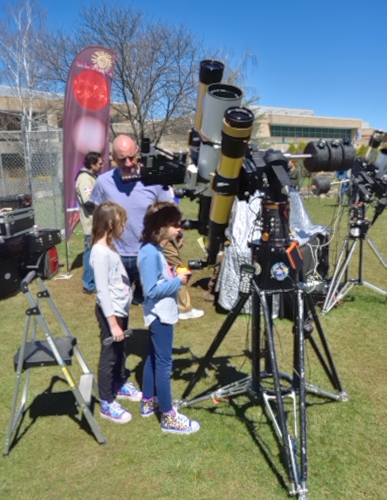
Sean Walker (S&T)
Observing Editor JR Johnson-Roehr: The big excitement at last year’s NEAF was Pluto and the New Horizons flyby. This year, the buzz was all about the Sun, or more accurately, the upcoming total solar eclipse (August 21, 2017). Every NEAF, I contemplate my own solar set up as I wander the floor, asking myself if this is the year I move from single to double stack for h-Alpha observing, or if I should finally buy a white-light filter for my 10-inch reflector (full disclosure: I picked up a Celestron heavy-duty tripod for my Coronado PST from Camera Concepts & Telescope Solutions instead of buying a white-light filter). It seemed as if every vendor had solar-observing equipment on display. I was pleased to see that in addition to their high-end scopes, Lunt brought along their series of handheld (6×30 and 8×32) white-light binos. Much of the weekend’s discussion was about outreach and getting bystanders excited about August’s solar eclipse, and these entry-level tools will certainly provide an assist in that area.
I hope novice observers especially had a chance to stop at the booth or spend time on the solar-observing field supported by the Charlie Bates Solar Astronomy Project (weather report: clear but cold on Saturday; clear and finally warm on Sunday). Michael Zeiler and Polly White of GreatAmericanEclipse.com also provided a wealth of information (especially maps!) for those seeking advice about the August event.
Of course, there was more than the eclipse at NEAF. I dropped into the Pro-Am Conference to hear Ted Blank of IOTA discuss the ins and out of timing asteroid occultations. I also had the chance to hear a few talks in the lecture hall on Saturday. James Albury and Dean Regas paid tribute to Jack Horkheimer’s legacy during their chat about the PBS series Star Gazers, and Todd May (NASA-MSFC) provided some insight into the technical challenges involved in developing a Mars exploration program, particularly in terms of launch vehicles and payloads. Sara Seager (MIT) clarified the possibilities and limits of the existing data on exoplanets, and updated us on the hunt for other habitable worlds.
On the show floor, I managed to check in with several of the regional clubs, such as those represented by the United Astronomy Clubs of New Jersey, as well as organizations like the Astronomical League, Stellafane, and Rutgers Engineering. And as S&T's book review editor, I enjoyed seeing what's coming up from Cambridge University Press, Wilmann-Bell, Inc., and Springer, among others.
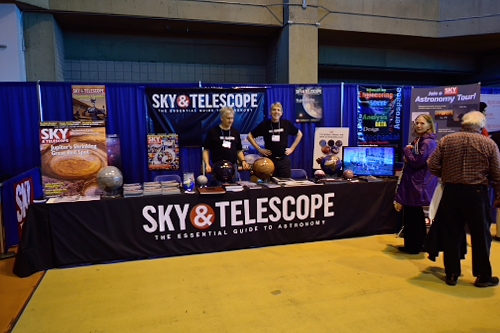
Sean Walker (S&T)
Senior Editor Alan MacRobert: Was this the biggest NEAF yet? It seemed that way. The crowds were thick and our booth was even more swarmed than usual, especially as the weekend got rolling on Saturday morning. We ran out of the white plastic Sky & Telescope bags every attendee was supposed to get. Some of the astronomy talks in the big auditorium were standing room only and then some; I was turned away from Sara Seager’s exoplanet talk by a guard who said the standees were at the fire-safety maximum. The average age struck me as slightly younger. Vendors told me the crowd was a buying crowd. Judging by last weekend, the future of amateur astronomy is looking up.
As usual, I was hoarse by the end of the day talking to so many of you dear readers (and this year, serving as carnival barker for our product raffle. I hope you had as much fun with this as I did.) If we ever wonder why we do all this, you sure remind us why.
It was particularly humbling to meet those of you who have been doing enthusiastic astro-outreach in various communities across decades. You have not only helped amateur astronomy thrive from generation to generation, you have helped build America’s scientific literacy and pro-science sentiment to . . . well . . . at least where it is. Which is better than many places. S&T depends on you and honors what you do. Please never quit.
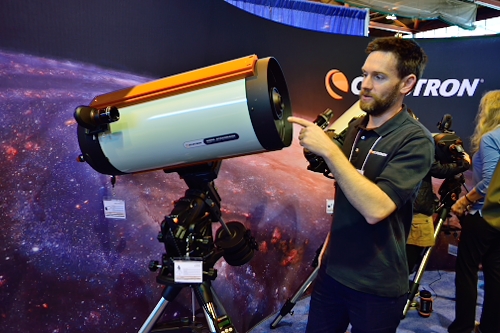
Sean Walker (S&T)
Equipment Editor Sean Walker: It was hard to walk the floor at NEAF this year without spotting something interesting. Among the many new astronomy gadgets that caught my attention were Tele Vue's intriguing collaboration with Tactical Night Vision Company, producing the TNV/PVS-14 working prototype of a night-vision eyepiece, using Gen III night vision technology. Can't wait to see this under the stars!
Meade Instruments showed off a new series of triplet APO refractors, as well as the StarNavigator NG series of Maksutovs and refractors on single-arm Go To fork mounts. Celestron also was on hand displaying their newest CGX and CGEX-L equatorial mounts with remote control capabilities. Not far away, Sky-Watcher turned lots of heads with their extremely light-weight Stargate truss-tube 18- and 20-inch Dobsonians with its SynScan Go To slewing and tracking.
Speaking of Dobs, Teeter's Telescopes showed off some very attractive Dobs, including the 12.5-inch Journey airline transportable scope, and a 16-inch light-weight Dob, as well as new upgrade options.
Camera trackers were popular at NEAF this year, and iOptron showcased several new versions of their SkyTracker and SkyGuider mounts, perfect for nightscape astrophotography, as well as eclipse imaging.
Across the hall, our friends at Denkmeier Optical wowed me with simulated 3D views through the company's L-O-A-21 3-D eyepieces (and a pair of binoculars using the same technology). Moonlite Telescope Accessories massive NiteCrawler remote rotator/focuser was interesting, especially when I envisioned pairing it to PlaneWave Instruments’ huge CDK 17 on a massive, robotic single-arm fork mount just across the aisle.
For astrophotographers, camera manufacturers SBIG, Atik, Starlight Xpress, Finger Lakes Instrumentation, iNova Technologies, and QHY were all on hand showing off the latest detectors, including a few wireless CCD cameras (one with a built-in CPU).
Plenty of gear was showcased with an eye toward the upcoming eclipse in August. Meade had a series of telescopes with easily-secured white-light solar filters, as well as their Coronado line of solar telescopes, and Daystar Filters showed off plenty of easy-to-assemble filters for telescopes, cameras, and other small optics (as well as their Quark Hydrogen-alpha filter units).
In the courtyard, Stephen Ramsden and members of his Charlie Bates Solar Astronomy Project were on hand to give attendees a good look at the Sun through solar scopes of all sizes, including the massive “Leviathan” 225-mm refractor driven all the way from Arizona by Pamela and Randy Shivak.
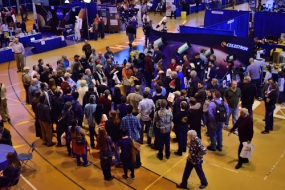
Sean Walker (S&T)
Senior Editor Kelly Beatty: The annual Northeast Astronomy Forum has always been a family-friendly environment (students get in for $10, children 12 and under are free). Some vendors offer astro-goodies specifically for small fry, and there's a kids' activity area as well.
Still, at this year's pilgrimage, I was struck by how many children roamed the aisles. Maybe it was the pleasant weather, with solar viewing through dozens of scopes just a few steps away, or maybe it's the building buzz about August's solar eclipse. Or maybe their parents were stealthily shopping for that all-important "first telescope." Whatever the reason, lots and lots of kids stopped by the S&T booth to chat.
Meanwhile, on the far side of the big field house, Astronomical League officers John Goss and Bill Borgardus had the pleasure of introducing some of this year's winners of the League's National Young Astronomer Awards:
- Sierra Bradley, winner of the Horkheimer/Smith Youth Service Award, spoke on her outreach efforts at public observing sessions, at schools, and at the Virginia Tech Science and Education Show.
- Perri Zilberman, who took first place in the National Young Astronomer Award, described his project, "The Occurrence Rate of Hot Jupiter Host Stars with Warm Debris Disks."
- Shanmurugan Selvamurugan, second-place finisher for the NYAA, spoke about his project, "Metallic Tendencies of Terrestrial Planet and Gas Giant Formation and Evolution."
All three of them received a plaque and either a check or an Explore Scientific telescope. Other award-winners will be announced next month. This important program is helping to encourage and promote students across the country to get and remain passionate about astronomy. So kudos to NEAF's organizers, the Astronomical League, and Scott Roberts of Explore Scientific for helping to cultivate the next generation of amateur astronomers.
 4
4









Comments
Wayne -Hixson
April 12, 2017 at 3:22 pm
Thanks for the great coverage. It is especially l gratifying to hear about the youth attendance. Will we be getting the great videos like Dennis di Cicco does every year? Next best thing to being there!
You must be logged in to post a comment.
JRPost Author
April 12, 2017 at 7:01 pm
Yep, you'll be seeing them posted here soon!
You must be logged in to post a comment.
May 8, 2017 at 2:41 pm
And when is "soon"? 🙂
You must be logged in to post a comment.
Monica Young
May 8, 2017 at 4:25 pm
It takes some time to process the videos, but we expect their release before the end of the summer.
You must be logged in to post a comment.
You must be logged in to post a comment.